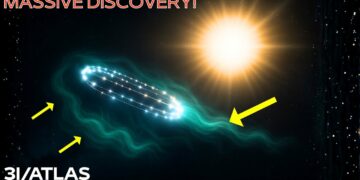Picture gazing into the vastness of the universe, only to realize it’s gazing back. That’s the unsettling sensation scientists experienced when the James Webb Space Telescope, humanity’s most advanced observatory in space, uncovered something extraordinary. This wasn’t just another distant galaxy or a stunning nebula for NASA’s archives. It was a collection of signals, patterns, and anomalies that shattered every assumption we held about the cosmos. At first, they appeared chaotic. But the deeper scientists looked, the more these findings seemed intentional, organized, and—some dared to suggest—intelligent. For years, we’ve viewed the universe as a cold, indifferent void, ruled by physics and chance. But what if we’ve been mistaken? What if, buried in the silence of deep space, there are messages waiting to be discovered? Messages we were never meant to find? Today, we explore the latest data from the James Webb Space Telescope—data so startling, so unprecedented, that some astronomers are beginning to ask the unthinkable: Are we on the verge of proving we’re not alone?
The journey started with a surprising discovery closer to home. The telescope turned its gaze toward Neptune, an icy giant at the edge of our solar system, a world so remote and frigid it seems locked in time. Yet, Webb revealed something that upended decades of scientific understanding. Compared to data from Voyager 2’s 1989 flyby and recent Earth-based observations, Neptune’s upper atmosphere had cooled dramatically—by nearly 10°C in just a few decades, with no apparent cause. Solar cycles couldn’t explain it. Neither could internal heat fluctuations. Even more unsettling, Webb detected subtle shifts in Neptune’s magnetosphere—faint but undeniable, like a pulse from an unseen source. Could an external force be at play? A passing gravitational anomaly? A shift in dark matter? Or something stranger, silently influencing planets across vast distances? This anomaly was the first clue, opening a door to a mystery far greater than ice.
While the Neptune findings sparked unease, what Webb uncovered in the Trappist-1 system forced scientists to rethink exoplanetary science entirely. Located just 39 light-years away, Trappist-1 is known for its seven rocky planets, three of which lie in the habitable zone. But Webb didn’t just confirm their potential—it revealed something profound. Using infrared spectroscopy, the telescope detected clear signs of water vapor in the atmospheres of at least two planets, Trappist-1d and 1e. These weren’t mere traces; the data pointed to dense, humid atmospheres, possibly with cloud systems akin to Earth’s. Combined with temperature profiles and orbital patterns, the evidence suggested global oceans—deep, stable, and ancient. Even more astonishing, Webb identified ozone-like compounds, molecules that on Earth are tied to biological processes. It’s not definitive proof of life, but it’s the closest we’ve come to finding the conditions for it, not once but twice in a single star system. Imagine a miniature solar system with multiple Earth-like worlds orbiting silently in the dark. Webb has shown they’re not just theoretical—they’re real, vibrant, and potentially alive.
Closer to home, these discoveries were staggering, but Webb’s gaze into the ancient universe revealed even more. In one of its deepest surveys, it captured light from JADES-GS-z13-0, a galaxy formed just 330 million years after the Big Bang. What puzzled researchers wasn’t the galaxy itself but the Lyman-alpha radiation it emitted—a frequency typically absorbed by neutral hydrogen clouds in the early universe. Yet, this signal was too strong, too clear, as if the hydrogen had already been ionized, letting the light pass freely. This finding upends our understanding of the epoch of reionization, when the universe transitioned from darkness to light. If this galaxy emitted such radiation so early, it suggests something—perhaps massive, perhaps intelligent—accelerated the process. Was it a natural phenomenon, or the trace of something deliberate, like early galactic engineering or an unknown energy source igniting the cosmos prematurely? The implications are profound, shifting the question from what happened to why—and who, if anyone, was there.
Turning to white dwarf systems—stars that have already died—scientists expected only remnants and silence. Instead, Webb found planets that defied their fate. In the WD 1856+534 system, it detected a massive gas planet orbiting just millions of kilometers from a dead star. This shouldn’t be possible; a star’s transformation into a white dwarf typically obliterates nearby objects. Yet, this planet was not only intact but in equilibrium. Even more striking, Webb’s instruments found traces of vaporized water, sulfur compounds, and other chemical markers in its atmosphere, suggesting active regeneration. Somehow, this planet had adapted to survive its star’s death. This discovery challenges the assumption that a star’s demise ends all prospects for life. What if civilizations or ecosystems exist around dying stars, sustained by alternative energy sources? White dwarfs, once symbols of cosmic endings, might now be prime candidates for finding intelligent life thriving amid the ruins.
Webb also turned its attention to the outer moons of Uranus and Neptune, long thought to be dormant, icy rocks. Instead, infrared mapping revealed thermal signatures on small moons like Hippocamp and Despina, far above expected levels, hinting at geological or cryovolcanic activity. Even more intriguing, Webb’s spectrometers detected complex carbon compounds—possible organic precursors—on their surfaces. How could such distant, frozen bodies sustain internal energy for billions of years? Theories like radioactive decay or tidal heating fall short of explaining the compounds’ organization, raising a third possibility: external seeding. Could these moons be relics of something ancient, carrying traces of an outside influence?
Then, in the well-studied Messier 82, or Cigar Galaxy, Webb detected something extraordinary: a repeating infrared pulse from its core, not random noise but a structured signal with mathematical spacing and rhythm, resembling artificial modulation. While some attribute it to natural phenomena like a spinning neutron star, no visible or X-ray signals match the pattern. This raises a chilling possibility: Could this be the fading echo of a signal not meant for us?
Revisiting Tabby’s Star (KIC 8462852), famous for its erratic dimming, Webb deepened the mystery. Its precise data ruled out dust or comets, revealing thin, opaque, possibly massive objects passing in front of the star at regular intervals. These objects appeared flat and angular, with thermal sensors detecting waste heat—a faint infrared glow suggesting energy harvesting. The idea of a Dyson swarm, once science fiction, is now a serious hypothesis.
Finally, in Abell 2744, or Pandora’s Cluster, Webb observed shadows crossing a background galaxy during long exposures. These weren’t errors but actual occultations by invisible objects—massive, non-reflective, and possibly mechanical. Something moved through the gravitational lens, detectable only by what it blocked.
The James Webb Space Telescope isn’t just revealing beauty or science—it’s unveiling something deeper, almost forbidden. From Neptune’s anomalies to Trappist-1’s oceans, from ancient galactic signals to resilient planets orbiting dead stars, these discoveries challenge our understanding and whisper a single question: What if the universe is not empty? What if it’s aware, watching, or even warning us? Webb has lifted a veil we didn’t know existed, and there’s no going back. We stand on the brink of a revelation that could redefine humanity. If this stirs you, subscribe to stay updated on Webb’s next findings. Comment below: What do you think is out there? Share this with someone ready to question everything.























